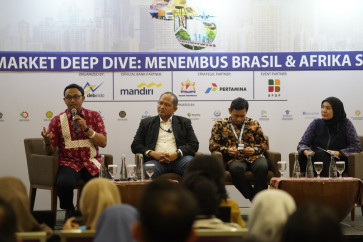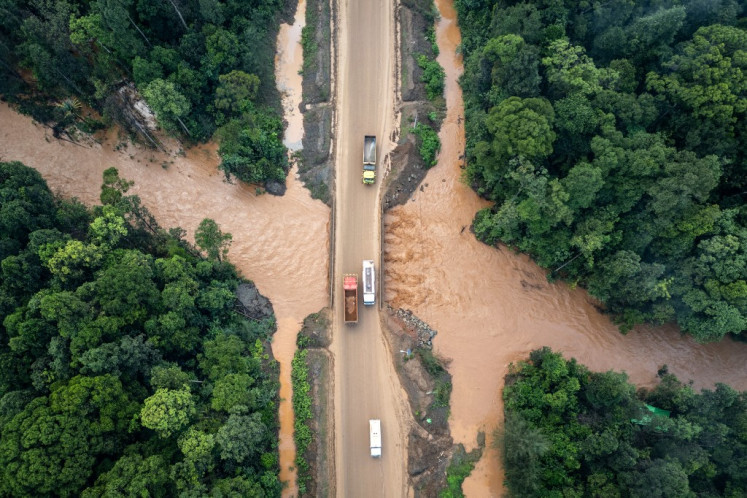Popular Reads
Top Results
Can't find what you're looking for?
View all search resultsPopular Reads
Top Results
Can't find what you're looking for?
View all search resultsGovt warned of huge impact of sea dike
New playground: Students play on part of the seawall in Kalibaru, Jakarta, on Monday
Change text size
Gift Premium Articles
to Anyone
N
ew playground: Students play on part of the seawall in Kalibaru, Jakarta, on Monday. Part of the National Capital Integrated Coastal Development (NCICD) project, the first phase of construction is costing Rp 9.4 trillion (US$674.5 million).(JP/Wendra Ajistyatama)
The government’s newest proposal for phase two of Jakarta’s outer sea dike project — previously referred to as a giant seawall or the Great Garuda — has raised questions and concerns from activists and scholars who warn of the potential environmental and social costs of the mega project.
The Public Works and Housing Ministry, which is in charge of the project, is preparing to send its proposal for the new concept to President Joko “Jokowi” Widodo. The ministry signed an agreement with its counterpart from the Netherlands and South Korea last month for the sea dike’s construction.
Officially called the National Capital Integrated Coastal Development (NCICD) project, the sea dike’s primary function is to reduce the threat of tidal floods in Jakarta as a result of land subsidence. Experts have warned that the capital was sinking at a rapid rate in some areas, especially in West and North Jakarta.
Speaking to The Jakarta Post, Bogor Institute of Agriculture’s School of Maritime Affairs and Fisheries professor Etty Riani said any form of development would have an environmental impact, but the negative impacts should be minimized through technology.
“Please be [thorough] in making an environmental analysis document [Amdal]. When deciding on a location for a reclamation project, assess the [marine] area’s ecological conditions. Do animals use it as a spawning ground or nursery ground? Assess [the location] first, then decide,” she said.
“If the water is already heavily polluted and has lost its ecosystem, the area could be reclaimed — but it all depends on the [environmental conditions]. Conduct a study on the carrying capacity and environmental capacity. Mitigation must start from the beginning [of a reclamation project].
The NCICD project, which will cost Rp 262.2 trillion (US$18.6 billion) in total, will include 2,000 hectares of reclaimed land for commercial purposes.

NCICD, seawall (JP/Swi Handono)
According to SMERU Research Institute researcher Rendy A. Diningrat, any infrastructure development, regardless of its size, must involve efforts to help people affected by the project adapt to the new environment.
“The government’s duty is to improve its people’s ability to earn a living so that they are prepared to be anything — fisherfolk or anything they choose to be,” he said, adding that the government usually neglected this aspect.
NCICD project adviser Andi Baso, who works for the Public Works and Housing Ministry, recently told the Post that the sea dike would also function as a toll road. In addition to mitigating the impact of tidal floods, the sea dike is also expected to ease traffic in Jakarta, he added.
But according to Marthin Hadiwinata from the Indonesian Traditional Fishermen’s Association, which has long criticized the project, a sea dike and artificial islands would not help solve Jakarta’s land subsidence problem. He also pointed out that the capital did not need a new toll road.
“The fundamental problem in our transportation sector is not a lack of loads but a lack of proper modes of public transportation,” he said. “[The sea dike toll road] would just add to the list of infrastructure projects established without basic studies on the necessity of building a toll road.”
He also demanded that the central government thoroughly review the project’s Strategic Environment Assessment (KLHS) to minimize its environmental impact.
“The assessment has to be clear in calculating the volume of external load discharged into Jakarta Bay, such as sedimentation, changing current patterns, water pollution from the city’s 13 rivers and wastewater treatment from businesses and households,” he said.
Dwi Sawung, Indonesian Forum for the Environment’s (Walhi) head campaigner for energy and urban issues, said the project seemed like a pretext for building another toll road and new land for developers at the expense of the environment.
“For us, [the new second-phase concept] is not much different from the previous [proposal] and will create a new problem instead,” he said, questioning studies on parameters such as sedimentation, seawater quality and natural flushing capacity of the area.
He also said that using the sea dike as a toll road would be counterintuitive to Jakarta’s efforts to tackle air pollution, which mostly came from vehicle emissions.
Meanwhile, the People’s Coalition for Fisheries Justice (KIARA) general-secretary Susan Herawati raised concerns that the proposed concept would further damage the Jakarta Bay ecosystem and ecology.
“The project does not answer problems the fisherfolk have been facing in Jakarta Bay, let alone flooding or disaster,” she said while further questioning the necessity of the projects.
“The project only copies the development pattern of countries like the Netherlands and South Korea. If you think about it, Jakarta doesn’t need [a sea dike],” she said.










